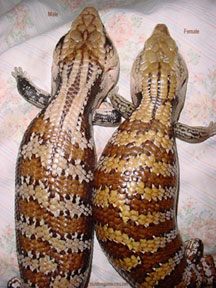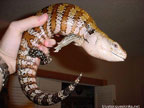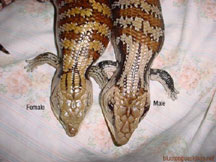Taken from the book:
"A Comprehensive Guide to the Natural History and Captive
Husbandry of Blue-tongued Skinks in the Genus Tiliqua"
By: James Wilson

The Irian Jaya blue-tongued skink was recently discovered in the early 1990s,
and currently remains undescribed and unnamed. Many hobbyists believe it to
be a 4th scincoides subspecies. For the first few years after the Irian Jaya
blue-tongue's discovery, it was considered quite rare, and it carried a very
expensive price tag. Because of its hardiness and its similar appearance and
disposition to the Common Australian Blue-tongue, it became very popular in
the pet trade. In time it became fairly inexpensive, and for a time, replaced
the Indonesian blue-tongued skink (Tiliqua gigas) as this country's new and
improved blue-tongue import staple.
There is a lot of confusion in regard to the origin and identification of the
Irian Jaya blue-tongue, causing it to be frequently misidentified. The Irian
Jaya blue-tongued skink has become common in U.S. collections due to the
large numbers of them that have been imported in recent years. In spite of this,
there is still very little information published about them in current
literature. What has been published has usually proven to be misleading, causing
even more confusion.
Once the Irian Jaya blue-tongue secured a place in the reptile hobby,
importers started calling it the New Guinea blue-tongue. This new name seemed
appropriate since this skink is from all of New Guinea, including Papua and Irian
Jaya. Unfortunately, this name is also another misused common name for the
Indonesian blue-tongued skink (Tiliqua gigas), which also shares New Guinea as a
portion of its range. Now, there is at least one book available that pictures
both species under this same common name. For obvious reasons I avoid using
the term "New Guinea Blue-tongue" so as not to create or perpetuate any more
misinformation.
There are many people who find it suspicious that such a large skink could go
undiscovered for so long, and once again, there are those who embrace the
conspiracy theories. Some literature claims that the Irian Jaya blue-tongue is a
man-made mutt, possibly created by intergrading the two Australian scincoides
subspecies, smuggeling them out of Australia, and then exporting them out of
Irian Jaya with false locality data in order to mask their true origin and to
create a more marketable blue-tongued skink for importation. It has been
further suggested that other Australian skinks may have been smuggled by
unscrupulous individuals into Irian Jaya, and then hybridized on large scale breeding
farms, with some animals either escaping or being released into the wild so as
to populate the area for future harvesting. There is obviously a great deal
of speculation in regards to this "new" blue-tongue, and I feel that it is
necessary to set the record straight.
When all of the speculation started, the Irian Jaya blue-tongue was still
quite rare and very expensive. At that time this would have provided the motive
for the greedy smugglers and exporters, creating at least some basis for the
conspiracy theory supporters. However, Irian Jaya blue-tongues were soon
imported in large numbers, and have become one of the most affordable of all of the
blue-tongues on the market, laying the motive of greed to rest, and making
this crime basically impossible to accomplish, due to shear numbers alone.
There is simply no way that a smuggling operation of such a large scale could go
on without detection for over ten years.
The fact that the Irian Jaya blue-tongue does bear some resemblance to the
Australian scincoides does not mean that it is actually a scincoides subspecies.
It does, however, raise some interesting questions. The Irian Jaya
blue-tongue also shares many physical similarities with the Indonesian blue-tongued
skink Tiliqua gigas, while inhabiting a geographic range that falls directly
between these two different species. I have also found the Irian Jaya
blue-tongue to be totally inconsistent in its color, pattern, and overall morphology,
often making identification quite difficult. It is only by using the process of
elimination that I am able to identify a given specimen as the Irian Jaya
blue-tongued skink. Basically, if it does not fit the bill for any of the other
currently described and accepted Tiliqua species or subspecies, then it is an
Irian Jaya blue-tongued skink. This skink does not follow any of the rules.
In the past, I have been able to take one T. scincoides and one T. gigas and
place them on opposite ends of a table with 8 Irian Jaya blue-tongues in
between, creating a line of natural progression that flows so smoothly from one end
to the other that there is no place to draw a line between the two species.
Also of interest is the fact that when the Irian Jaya blue-tongue is cross bred
with any other Tiliqua species or subspecies, the offspring always come out
looking like Irian Jaya blue-tongues. The same can be said for intergrade
offspring that I have seen from a breeding between T. g. gigas and T. g.
evanescens. What does all of this suggest?
In order to get some idea as to the actual origin of the Irian Jaya
blue-tongue, we should first look at the evolutionary origins of the genus Tiliqua in
New Guinea. Evidence suggests that T. gigas is the sister species to T.
scincoides, and that these two form a clade that is a sister clade to remaining
Tiliqua species (possibly excluding T. adelaidensis). Experts also agree that
Tiliqua is the sister taxon to Cyclodomorphus, Trachydosaurus, and
Hemisphaeriodon, all of which are exclusive to Australia. Knowing this, it is quite safe to
conclude that Tiliqua is an Australian genus, and that T. gigas evolved form
an Australian ancestor.
According to Dr. Glenn Shea, there are two different theories as to how this
may have happened, and what role it plays in the Irian Jaya blue-tongued
skink's origin. The first is that T. scincoides dispersed into New Guinea across
the Torres Straight via an existing land bridge thus giving rise to T. gigas,
afterwhich a second scincoides invasion to the extreme south occurred with the
later closure of the Torres Strait and the subsequent hybridization that
resulted in a population of hybrid animals that gave rise to the Irian Jaya
blue-tongued skink. The second theory is that a common ancestor which occurred in
both Australia and New Guinea evolved separately into T. gigas and T. scincoides
due to some geographical barrier(s) other than the Torres Strait in New
Guinea (possibly the Maoke mountain range). Hybridization resulted from the
subsequent reintroduction of the two different species that later became isolated due
to the closure of the Torres Straight, leaving us with the hybrid population
of animals that we now know as the Irian Jaya blue-tongued skink. Both
theories basically suggest the same thing, and that is that the Irian Jaya
blue-tongued skink is the result of past hybridization between T. gigas and T.
scincoides.
While the elaborate conspiracy schemes make for exciting writing, they are
based on weak logic, employing many fallacies in reasoning, and are written by
individuals with limited or no experience on the subject. After reviewing all
of the evidence, I have to agree with Dr. Shea in that the Irian Jaya
blue-tongue is a naturally occurring hybrid population that went overlooked in a
country that has new reptiles being discovered every year. Unfortunately, because
of these findings it is very unlikely that this skink will ever be given its
own scientific designation. However, there are currently genetic studies being
performed to detect if there has been any hybridization, and how this unique
and popular blue-tongued skink fits into the genetic puzzle in comparison with
the other described species.

Description
The Irian Jaya blue-tongued skink is one of the more variable
blue-tongues. It often looks almost like a cross between the Eastern, Northern,
and the Indonesian blue-tongued skinks, borrowing different characteristics
from each of them. It is common for many of these characteristics to be
inconsistent, and or muted, thus, making identification difficult, and adding to its
already confusing status. Like the eastern blue-tongue, it has the bold
bands, that cross over the back and onto the sides. The head is variable, often
resembling the northern blue-tongue which lacks the dark temporal streak. There
are exceptions, with some individuals having strong temporal streaks, which is
a trait known to some populations of the Eastern blue-tongue. The Irian Jaya
blue-tongue's tail is longer than the other two Australian subspecies,
accounting for 65-85% of the snout-vent length. The forelimbs are also quite
variable, ranging from dark brown (but never black) with some cream flecking on them
(resembling the Indonesian) to a lighter brown with almost no flecking on
them (looking more like, but not as light as, the Eastern or Northern
blue-tongues). The hind limbs are usually darker than the forelimbs, and very often have
large cream spots on them. Their anterior temporal scales are elongated and
much longer than the other temporal scales. With a maximum size of 22 inches
(56 cm), the Irian Jaya blue-tongue is a relatively large blue-tongue that can
produce up to 15, unusually large, live young in a litter.
Distribution and habitat
The Irian Jaya blue-tongued skink inhabits the dry
tropical regions of southern coastal New Guinea that are similar in climate
and habitat to adjacent northern Australia. Its range includes both Irian Jaya
(the western half of New Guniea that is governed by Indonesia, and allows
exportation of its wildlife), and Papua, New Guinea (the eastern half of New
Guinea that is governed by Australia, and allows no exportation of its wildlife.)

 ®
®
 ®
®